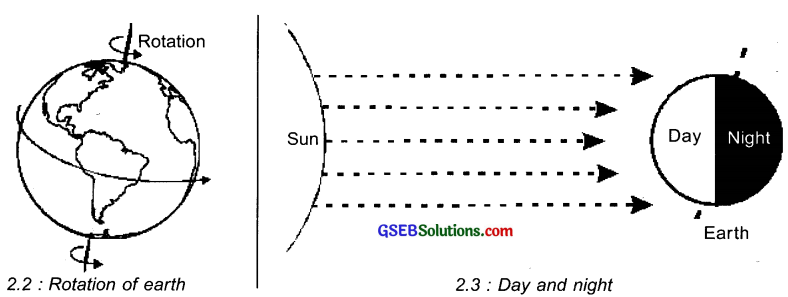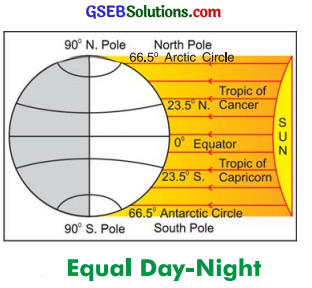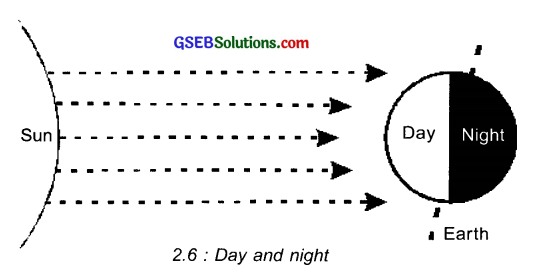Gujarat Board GSEB Solutions Class 7 Social Science Chapter 2 Motions of the Earth Textbook Exercise Important Questions and Answers, Notes Pdf.
Gujarat Board Textbook Solutions Class 7 Social Science Chapter 2 Motions of the Earth
GSEB Class 7 Social Science Motions of the Earth Textbook Questions and Answers
Answer the following questions in brief
Question 1.
Which are the two motions of the earth? or How many types of motion are there of the earth? Name them.
Answer:
A. Rotation on its own axis,
B. Revolution around the sun
Question 2.
What would happen if the earth did not revolve around the sun?
Answer:
There would be no day or night neither there would be changes in season.
![]()
Question 3.
There is a test match between India and West Indies in West Indies. At what period of the day will you watch this match – day or night?
Answer:
If the match is played during the day in West Indies, I will watch it at night in India or vice versa.
Question 4.
How is your shadow during morning, afternoon and evening? or What is the length and direction of your shadow ¡n the morning, afternoon and evening?
Answer:

Question 5.
The sun is never overhead in London and the sunlight is there till 8 o’clock in the evening; whereas the sun is seen overhead in Singapore. Give reason.
Answer:
- The rays of the sun directly fall on Equator and the places located near it.
- Singapore lies right near the Equator.
- Hence, the sun is seen overhead on it.
- On the other hand, London lies near the Tropic of Cancer.
- Locations on and around the Tropic of Cancer receive slightly slant sunrays but for longer period.
- Hence, the sun is never seen overhead in London yet the sunlight remains till 8 o’clock.
GSEB Class 7 Social Science Motions of the Earth Additional Important Questions and Answers
Question 1.
Explain the motion of earth.
Answer:

- Like all the other moving elements of the universe, the earth also moves in two ways.
- One, it rotates on its own axis and second, it also revolves around the sun.
- Thus, the motion of the earth takes place in two ways.
- However, it is not only the earth that moves.
- All the elements of the universe – sun, moon and earth perform motion.
![]()
Question 2.
Write a short note on the rotation of earth.
Answer:
- The movement of the earth on its own imaginary axis is called the rotation of earth.
- Just as a top rotates on its own axis, the earth also rotates on its own imaginary axis.
- The imaginary axis can be considered perpendicular to the Equator.
- The earth rotates with a speed of 1670 km/hour. With this speed, it takes 24 hours to complete one rotation. Hence, our one day is of 24 hours.
- Day and night are possible only due to the rotation of earth.
- The part of the earth which faces the sun observes day while the one on the other side observes night.

Question 3.
When it is day in India, what is there in other countries? Write down.
Answer:

Question 4.
Write a short note on the revolution of earth.
Answer:
- The earth rotates on its own axis and also revolves around the sun.
- The movement of the earth around the sun on an imaginary path is called revolution.
- This imaginary path is called orbit.
- The orbit of the earth is oval or egg-shaped or elliptical in shape.
- Due to the non-circular orbit of the earth around the sun, its distance from the sun is not the same throughout the year.
- The earth revolves around the sun at the speed of 1760 km/min.
- With this speed, it takes 365 days for the earth to complete one revolution. This period is known as a year.
- Different seasons occur on earth due to the revolution of the earth.
- The tilt of the earth on its axis results into different seasons.
- It also results into long days and short nights or vice versa.
- The earth makes angle on its axis at 23.5° and on its orbit at 66.5°.
Question 5.
Draw a diagram of the various latitudes of the earth.

![]()
Question 6.
Look at the picture given below and answer the questions that follow:

Question:
(i) How long is the day on the Tropic of Cancer on 21st June?
(ii) Which season will be experienced mostly on the Tropic of Cancer?
(iii) What would be the length of day and night?
(iv) What will happen on the Tropic of Capricorn on 22nd December?
(v) For how many hours will Tropic of Capricorn experience daylight on 22nd December?
Answer:
(i) It will be a long day of about 14 hours on 21st June on the Tropic of Cancer.
(ii) Tropic of Cancer will mostly experience summer season.
(iii) The day would be long while the night will be short.
(iv) Tropic of Capricorn will experience a long day and summer season on 22nd December.
(v) Tropic of Capricorn will experience about 14 hours of daylight on 22nd December.
Question 7.
How do days and nights become long and short? OR Why do the lengths of days and nights differ?
Answer:
- The earth revolves around the sun on its own orbit.
- It forms an angle at 66.5° on its orbit.
- Hence the Northern and Southern Hemispheres face the sun one by one.
- The hemisphere that faces the sun for a long time receives straight light of the sun.
- The days are longer and nights are shorter on such places.
- On the other hand, the places where the rays of the sun fall slant observe shorter days and longer nights.
- Thus, the length of the days and nights depends on the rotation of the earth.
Question 8.
How do day and night occur on the earth?
Answer:
- The earth is round.
- It keeps on rotating on its own axis.
- The part of the earth that faces the sun receives sunlight while the other half part of the earth remains in dark.
- Thus, the first part observes day while the other one faces night.
- As the earth rotates, the day turns into night and night turns into day slowly.

Question 9.
Explain the cycle of seasons. OR Explain how changes in seasons occur.
Answer:

- The earth revolves around the sun.
- When it revolves as well as rotates at the same time, it tilts in one direction.
- The part of the earth that tilts towards the sun receives straight and direct rays of the sun.
- Straight rays of the sun provide more heat and sunlight to the earth.
- Also, the length of the day increases.
- Hence, that part of the earth experiences summer.
- The hemisphere of the earth on the opposite side receives slant rays of the sun.
- Slant rays provide lesser heat.
- Also, the length of the night increases while that of the day decreases.
- Hence, this part of the earth experiences winter.
- Thus, when it is summer in the Northern Hemisphere, it is winter in the Southern Hemisphere.
- This is how the cycle of seasons works.
- The change of season directly affects the life of human beings.
![]()
Question 10.
List of the festivals and seasons celebrated in India are given below. Which seasons are there in other countries of the world? Find and write in the table.

(Answers: 1-Summer, 2-Winter, 3-Winter, 4-Winter, 5-Winter, 6-Winter)
Question 11.
Norway is called the ‘Country of the Midnight Sun’. Give reason.
Answer:
- Norway is located in the Northern Hemisphere of the earth.
- The Northern Hemisphere experiences summer between 21 March to 23 September.
- During this period, the sun never sets near the Arctic Circle between mid May to the end of July.
- During this period, as soon as the sun sets, it rises again near the Arctic Circle.
- The sun is seen even at 12 o’clock in the night in such locations.
- Norway is one such country that faces this situation.
- Hence, it is called the ‘Country of the Midnight Sun’.
Answer in One or Two Sentences
Note : Here, answers are given in short for memorizing easily. Students must write full sentences
Question 1.
Define: Rotation of earth.
Answer:
The circular movement of earth on its own imaginary axis is ……………..
Question 2.
At what speed does the earth rotate? How long does it take to complete one circle of rotation?
Answer:
1670 km/hour; 24 hours.
Question 3.
Define: Revolution of earth.
Answer:
The movement of the earth around the sun on an imaginary path is ……………….
Question 4.
Define: Orbit.
Answer:
The imaginary path in the space on which the earth revolves around the sun is ………………
Question 5.
What is the shape of the orbit?
Answer:
Oval or egg-shaped or elliptical
Question 6.
At what speed does the earth revolve? How long does it take to complete one circle of revolution?
Answer:
1760 km/mm; 365 days or one year.
![]()
Question 7.
What is a year?
Answer:
A period of 365 days which the earth requires to complete one revolution
Question 8.
Why do seasons occur?
Answer:
Due to the revolution and tilt of the earth.
Question 9.
In which places are days longer?
Answer:
Where the rays of the sun fall straight.
Question 10.
In which places are days shorter?
Answer:
Where the rays of the sun fall slant.
Question 11.
Why do day and night occur?
Answer:
Due to rotation of earth.
Question 12.
When do the rays of the sun fall directly on the Equator?
Answer:
On 21st March and 23rd September.
Multiple Choice Questions
Question 1.
Which element of the universe moves?
(A) Sun
(B) Moon
(C) Earth
(D) All of these
Answer:
(D) All of these
![]()
Question 2.
The earth rotates ……………….. .
(A) On its own axis
(B) Around the sun
(C) Both of these
(D) None of these
Answer:
(A) On its own axis
Question 3.
The imaginary axis dividing the earth in exactly two parts is called ……………….. .
(A) Equator
(B) Tropic of Cancer
(C) Arctic Circle
(D) South Pole
Answer:
(A) Equator
Question 4.
What is the shape of the orbit of the earth?
(A) Oval
(B) Egg-shaped
(C) Elliptical
(D) All of these
Answer:
(D) All of these
Question 5.
The earth revolves around the sun at the speed of …………….. .
(A) 1760 km/hour
(B) 1670 km/hour
(C) 1760 km/min
(D) 1670 km/min
Answer:
(C) 1760 km/min
Question 6.
The moon revolves around the ………………. .
(A) Sun
(B) Earth
(C) Both of these
(D) None of these
Answer:
(B) Earth
Question 7.
The period of one revolution of the earth is called one ………………… .
(A) Day
(B) Month
(C) Year
(D) Hour
Answer:
(C) Year
![]()
Question 8.
The earth makes an angle at ………………… ° on its axis.
(A) 23.5
(B) 42.5
(C) 66.5
(D) 82.5
Answer:
(A) 23.5
Question 9.
The tilt of the earth on its axis results in ……………….. .
(A) Sunrise and sunset
(B) Revolution of earth
(C) Different seasons
(D) Rotation of earth
Answer:
(C) Different seasons
Question 10.
What is located at 0°?
(A) Equator
(B) Pole
(C) Arctic Circle
(D) Antarctic Circle
Answer:
(A) Equator
Question 11.
0° : Equator: ……………… : North Pole.
(A) 90° N
(B) 90° S
(C) 23.5° N
(D) 23.5° S
Answer:
(A) 90° N
Question 12.
Equator: 0° : Antarctic Circle: ……………….. .
(A) 90° N
(B) 66.5° N
(C) 90° S
(D) 66.5° S
Answer:
(D) 66.5° S
Question 13.
Tropic of Capricorn is located at …………………. .
(A) 66.5° N
(B) 23.5° N
(C) 23.5° S
(D) 66.5° S
Answer:
(C) 23.5° S
![]()
Question 14.
The earth makes an angle on its orbit at ………………..°.
(A) 23.5
(B) 42.5
(C) 66.5
(D) 82.5
Answer:
(C) 66.5
Question 15.
The light circle (Prakash vartul) joins both the ……………… .
(A) Tropics
(B) Circle
(C) Poles
(D) Zones
Answer:
(C) Poles
Question 16.
The rays of the sun fall straight on the ……………….. on ………………. .
(A) Tropic of Cancer, 21st June
(B) Tropic of Capricorn, 22nd November
(C) Arctic Circle, 12th August
(D) Antarctic Circle, 12th December
Answer:
(A) Tropic of Cancer, 21st June
Question 17.
The rays of the sun fall straight on the Tropic of Capricorn on ……………… .
(A) 23rd August
(B) 22nd December
(C) 29th September
(D) 21st June
Answer:
(B) 22nd December
Question 18.
The days are ………………. on the places where the rays of the sun fall ………………. .
(A) Long, slant
(B) Short, slant
(C) Long, straight
(D) Both B and C are correct
Answer:
(D) Both B and C are correct
Question 19.
Northern Hemisphere experiences summer between ………………. to ………………
(A) 21st June to 22nd December
(B) 21st March to 23rd September
(C) 23rd August to 25th November
(D) 23rd January to 25th April
Answer:
(B) 21st March to 23rd September
![]()
Question 20.
……………….. is the longest day.
(A) 21st June
(B) 21st March
(C) 22nd December
(D) 23rd September
Answer:
(A) 21st June
Question 21.
……………… is the shortest day.
(A) 21st June
(B) 21st March
(C) 22nd December
(D) 23rd September
Answer:
(C) 22nd December
Question 22.
In which season do we celebrate Holi?
(A) Summer
(B) Winter
(C) Monsoon
(D) Autumn
Answer:
(A) Summer
Question 23.
In ……………….. the sun does not set from mid May to the end of July.
(A) Germany
(B) France
(C) Norway
(D) Netherland
Answer:
(C) Norway
Question 24.
Norway is located in …………….. .
(A) Asia
(B) Russia
(C) Europe
(D) America
Answer:
(C) Europe
Question 25.
The sun is never overhead in ………………. .
(A) London
(B) Sydney
(C) Singapore
(D) Colombo
Answer:
(A) London
![]()
Fill in the blanks
1. The earth rotates at the speed of ……………….
Answer:
1670 km/hr
2. It takes ………………. for the earth to complete one circle of rotation.
Answer:
24 hours
3. It takes …………………. for the earth to complete one circle of revolution.
Answer:
365 days
4. The distance between the earth and the sun is not same throughout the year due to the …………………….. shaped orbit.
Answer:
Oval/egg
5. The ……………….. revolves around the earth.
Answer:
Moon
6. The ………………… of the earth is responsible for different seasons.
Answer:
Revolution
7. Days are long where the rays of the sun fall ………………. .
Answer:
Straight
![]()
8. The part of the earth which receives more sunlight experience ………………… season.
Answer:
Summer
9. Southern Hemisphere experiences winter between …………….. to …………….. (date).
Answer:
21st March, 23rd September
10. The rays of the sun fall straight on the ……………………. (latitude).
Answer:
Equator
11. We celebrate Diwali and Chnstmas in ……………. season.
Answer:
Winter
12. In ……………… country of Europe, the sun rises as soon as it sets from mid May to the end of July.
Answer:
Norway
13. From …………………. day onwards, the rays of the sun fall straight on the Equator.
Answer:
22nd December
![]()
14. Makarsankranti is observed when the sun enters the ……………… zodiac.
Answer:
Capricorn
15. From ………………….. date onwards, the straight rays of the sun move from the Tropic of Cancer to the south of Equator.
Answer:
22nd June
16. Celsius has been named after a ……………… astronomer.
Answer:
Swedish
17. One country where the sun is always on the overhead is ……………….. .
Answer:
Singapore
18. One city where the sunlight remains till 8 o’clock in the evening is ………………… .
Answer:
London
19. One country where the sun is seen even at 12 o’clock at night is ……………….. .
Answer:
Norway
20. Uttarayan is also called ………………. .
Answer:
Makarsankranti
![]()
Fill in the Table
Fill in the table given below with the help of the calendar (Gujarati Panchang) showing the time of sunrise and sunset.

True or False
1. The imaginary axis of earth’s rotation lies obliquely to the earth.
Answer:
False
2. The earth completes on revolution in one day i.e. 24 hours.
Answer:
False
3. Rotation of earth: 1670 km/hour; Revolution of earth: 1760 km/min.
Answer:
True
4. The earth revolves around the sun, maintaining a fix distance throughout the year.
Answer:
False
5. If India = Day, Australia = Day and Brazil = Night.
Answer:
True
6. Earth’s rotation is the reason for change in season.
Answer:
False
![]()
7. The north Hemisphere and the South Hemisphere face the sun simultaneously.
Answer:
False
8. Longest day comes in the month of December whereas shortest day in the month of June.
Answer:
False
9. The sun never sets near the Arctic circle between mid-May to July end.
Answer:
True
10. People of London are lucky enough to get only slanted sun rays.
Answer:
True